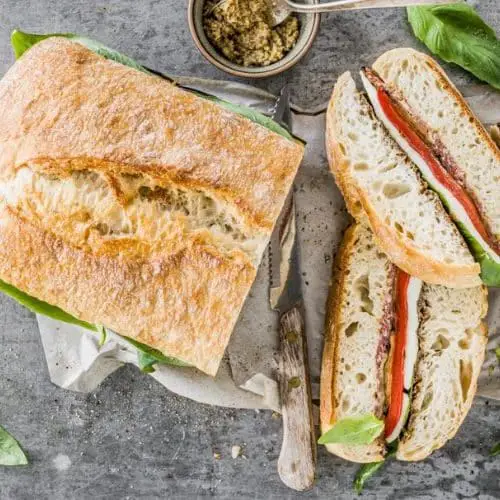
Ciabatta
Ciabatta is an Italian bread known for its rustic, irregular shape and airy, slightly chewy crumb. It features a crispy crust and is made with a high-hydration dough, which contributes to its open structure. With the use of a poolish starter and a two-step rise process, Ciabatta can be baked to perfection at home. This bread is perfect for sandwiches, as a dipping bread, or simply enjoyed with olive oil and balsamic vinegar.
Equipment
- 1 large mixing bowl
- 1 Dough scraper or spatula
- 1 measuring cup
- 1 Digital kitchen scale (optional for accuracy)
- 1 Baking stone or sheet
- 1 Parchment paper
- 1 Tea towel or plastic wrap
- 1 Wire rack (for cooling)
Ingredients
For the Poolish (Starter):
- 100 grams Bread flour
- 100 grams Water
- 0.1 grams Active dry yeast a pinch
For the Dough:
- 400 grams Bread flour
- 250 grams Water
- 10 grams Salt
- 2 grams Active dry yeast or 1/2 teaspoon
Instructions
Prepare the Poolish:
- In a small bowl, mix 100 grams of bread flour with 100 grams of water. Add a pinch (0.1 grams) of active dry yeast and stir until combined. Cover the bowl with a damp cloth and let it sit at room temperature for 12–16 hours (or overnight) until bubbly and slightly tangy.
Mix the Dough:
- In a large mixing bowl, combine the poolish with 400 grams of bread flour, 250 grams of water, 10 grams of salt, and 2 grams of yeast. Stir until the dough begins to come together.
Knead the Dough:
- Turn the dough out onto a lightly floured surface and knead for about 8-10 minutes. The dough will be sticky, but continue kneading until it becomes smooth and elastic. You can also use the stretch-and-fold method every 30 minutes during the first rise.
First Rise:
- Place the dough in a lightly oiled bowl and cover it with plastic wrap or a damp towel. Let the dough rise at room temperature for 1 to 1.5 hours, or until it has doubled in size.
Shape the Dough:
- Gently turn the dough out onto a floured surface. Stretch and fold the dough into a rough rectangular shape. Try to maintain the air bubbles inside.
Second Rise (Proofing):
- Transfer the dough to a parchment-lined baking sheet or a floured kitchen towel. Cover and let it rise for 45 minutes to 1 hour, or until slightly puffed.
Preheat the Oven:
- Preheat the oven to 450°F (230°C) for at least 30 minutes, placing a baking stone or sheet inside if you have one.
Bake the Ciabatta:
- Place the dough in the preheated oven and bake for 25–30 minutes. The bread should be golden brown with a crisp crust. To check doneness, tap the bottom of the loaf; it should sound hollow.
Cool:
- Allow the Ciabatta to cool on a wire rack for at least 30 minutes before slicing.
Notes
- Hydration: Ciabatta is a high-hydration bread, meaning the dough will be sticky and wet. This is normal and contributes to its open crumb. Be sure not to add too much extra flour during mixing or shaping.
- Poolish: If you don't have time for the overnight fermentation, you can skip the poolish and directly mix the ingredients. However, the flavor will not be as complex.
- Storage: Ciabatta is best eaten within the first few days. To store, wrap it in a clean kitchen towel or paper bag to preserve the crust. You can also freeze Ciabatta for up to a month.